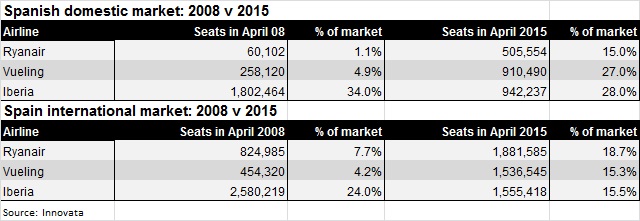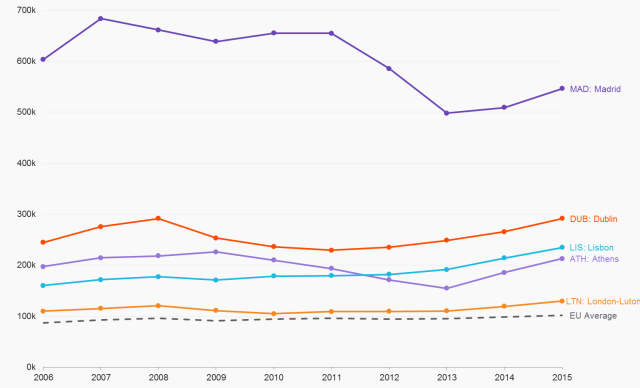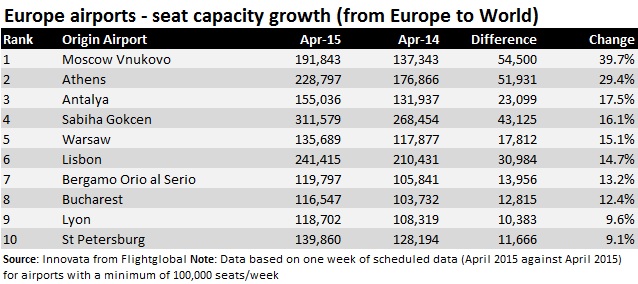Some of the European markets hardest hit by the recession, compounded by the debt and currency crisis in the eurozone that accompanied it, are now leading the pace of growth in the region.
Airports grouping ACI Europe reported that in October 2014 EU airports' passenger growth outpaced that of European emerging airports for the first time since 2006. While that in part reflects political and economic issues slowing the pace of growth in Russia in particular, it also illustrates the strength of the comeback among some of Europe's most beleaguered airports.
That recovery is being driven by continued low-cost carrier expansion, a return to growth among some restructured network carriers and the gradually improving economic picture – and is a product of the lows these markets reached. That many of the airports leading this growth – the likes of Athens, Dublin and Madrid – are still some way short of pre-crisis traffic peaks also tells its own story about how tumultuous a few years it has been for European aviation.
Andreas Kraus, associate partner responsible for the European market at Lufthansa Consulting, says the economic crisis has left its mark on the development of the aviation markets in the likes of Greece, Ireland, Portugal and Spain. "The all-time records of passenger volumes handled at Spanish, Greek and Irish airports still date back to 2007 – right before the full force of the financial crisis enfolded," he says. "The economic recession translated into a slump in national demand for air travel.
"Low-cost carriers have played a major role in increasing competitive pressure in these countries even before the crisis started. Today, the low-cost penetration in these countries tends to be one of the highest in Europe and the major city pairs are well served by LCCs, but this is not the end: LCCs will continue to invest more capacities and increase their destination portfolio also beyond European Union destinations. Any economic recovery will further support this trend," Kraus adds.
SPAIN
Ryanair's decision to start flights to Castellon airport in September tells us a lot about the fragile recovery of the Spanish aviation sector.
The airport has been empty since it was opened in 2011 and has the dubious honour of being included in the ranks of Spain's so-called "ghost airports" – facilities that were planned before the global crisis put the country into recession and have been unable to attract meaningful airline traffic.
But while Ryanair's decision to start flights to Castellon from London and Bristol is welcome news for airport operator SNC Lavalin, the airline's finance chief financial Neil Sorahan suggests it was not necessarily one spurred by a discernible improvement in the Spanish economy.
"Our model is a model that works very well in upturns and downturns. If you have the lowest costs and lowest fares, you are going to do well," Sorahan tells Flightglobal. "The markets, from our perspective, are going very, very well. We are already the number-one carrier in Spain. Bookings are very good."
Flightglobal's Innovata schedules data for April 2015 supports his comments, showing that Ryanair has a market-leading 18.6% of share of total seats, just ahead of IAG pair Iberia and Vueling.
A comparison of 2008 and 2015 gives an even more striking insight into the march of the low-cost carriers in Spain. In April 2008, before the global recession had taken full effect, Iberia dominated domestic flying in Spain, with more than 1.8 million monthly seats. Vueling accounted for 258,000 seats, while Ryanair operated just 60,000 seats.
Switch to 2015 and the picture is very different. Iberia has cut domestic capacity by half, to just under 950,000 seats, and Vueling has grown to almost parity with its IAG sister company. Ryanair, meanwhile, has mushroomed to over 500,000 seats.
On international routes to Spain, Ryanair has almost doubled its seat count to nearly 1.9 million, representing almost 19% of seat capacity by April 2015, while Iberia and Vueling were roughly at parity with 1.5 million seats.

Overall, the picture in Spain is one of retrenchment since April 2008. Domestic seat capacity is down 36.5% in April 2015 compared with the same month seven years ago. Alongside economic factors, increased competition from the high-speed train in Spain has been a factor – notably on what used to be Europe's thickest route, Barcelona-Madrid.
European seat capacity over the same period is down 9% and total international flights dropped 6.5%.

The economic slump also had the impact of putting additional pressure on national airlines and accelerating the process of privatisation and consolidation. As Kraus explains, the four countries "turned out to be laboratories for the transformation of European flag carriers".
In Spain, which had already seen Vueling merge with Barcelona rival Clickair, flag carrier Iberia merged with British Airways in January 2011 to form IAG. Vueling, itself already part-owned by Iberia, was added to the family in 2013.
The mergers led to a new phase of restructuring. Iberia has focused on its Madrid hub operations. Vueling and Iberia Express have expanded aggressively in domestic and international point-to-point markets to compete with the likes of Ryanair and Easyjet – while also providing feed services for Iberia. It's a model that is now being followed across Europe, Kraus says.
"Spain's national carrier Iberia has been in a continuous restructuring mode ever since the crisis started," he says. "This is where the model to transfer non-hub medium-haul routes to lower-cost production platforms such as initially Clickair – later merged into Vueling – was introduced in Europe. But the uphill struggle to achieve profitability continues."
Traffic trends at Madrid Barajas airport give some indication of the impact that restructuring and dampened demand have had on the Spanish capital. Passenger numbers fell every year – bar a modest increase in 2010 – from the high of 52 million in 2007 before the recession to under 40 million in 2013. But growth returned, aided in part by Iberia's return to growth mode, last year. The airport says passenger numbers grew nearly 12% in February over the same month in 2014 – its highest rate of percentage growth since 2007.
Innovata's April schedules data tracked over the last decade illustrates the extent to which seat capacity at Madrid (top line, below) fell during the recession and the speed at which it is being added back.

Source: Innovata
PORTUGAL
While Spain's aviation market is a long way from full recovery, neighbouring Portugal appears to be in better shape.
April data shows airlines have lifted international seat capacity by a third compared with the same month in 2008. Domestic seat capacity in April is around 12% higher than pre-crisis levels.
Ryanair has increased its share of seat capacity on European routes to Portugal, from 5.6% in April 2008 to more than a fifth. This makes the carrier the second largest on Portuguese routes, behind TAP Portugal. The latter's share of capacity fell from 39% in April 2008 to just under a third this month.
Easyjet made less impact, with its total share of the European-route seats market creeping up from 10% to 11.8% in the same period.
Ryanair and EasyJet's relative strength in the Portuguese market is likely to increase as new bases come fully on stream. EasyJet opened a new base at Porto in July 2014, joining an existing base at Lisbon which opened in 2012, while Ryanair opened a base at Lisbon a year ago.
Both low-cost carriers have entered the Portuguese domestic market but, it must be said, with mixed success. Ryanair withdrew a Porto-Lisbon route in just three days in April 2014 blaming capacity constraints. EasyJet flew just 24,600 monthly seats in the domestic market in April 2015 compared to TAP's almost 180,000.

The Portuguese government has kicked off a bid to find a buyer for up to 66% of state-owned TAP, two years after an initial privatisation process ended with rejection of the lone offer, from Synergy Aerospace.
But despite the airline's continued restructuring and pressure from rivals, Innovata schedules show TAP has managed to retain a commanding position at Lisbon airport, with 54% of total seats in April 2015..
"State-owned TAP Portugal's privatisation was only tackled once the EU and International Monetary Fund required this from the Portuguese government under the terms of the financial assistance package in 2011," says Kraus. "Unfortunately, this divestment process has not yet been finalised. Nevertheless, TAP's management did its best in refocusing the airlines business model and bringing costs under control.
"But it remains open [as] to what extent these efforts will contribute to shaping the carrier's future business model. The strong market position in Latin American growth markets remains TAP's core strategic value for potential investors and its corporate future will depend on its role within a new investor's airline group."
Innovata's April schedules data shows that Lisbon airport has managed to weather the worst of Europe's economic woes, and apart from a blip in 2009, has seen airlines increase seat capacity every year since the financial crisis. There were particularly strong increases last summer and again this year, in part driven by Ryanair's new Lisbon base.
GREECE
As the European country most affected by the global economic crisis, and even more directly by the eurozone woes, Greece would seem likely to have an aviation market that suffered seriously over the last eight years. But while the nation struggles with crushing debts, stringent obligations to pay back an international bailout and sky-high unemployment, its aviation market is back in growth mode.
Seat capacity on European routes to Greece has increased 17% between April 2008 and April 2015. This is driven by growth this and last year, a period in which Ryanair opened bases at both Athens and Thessaloniki, while Aegean returned to double-digit passenger growth after initial consolidation following acquisition of fellow Greek carrier Olympic Air.
Athens International airport is enjoying a particularly dramatic upturn. After traffic went into freefall in 2008/09, passenger numbers began rallying in 2013 and have since been growing at double-digit rates each month. Innovata's April schedules data shows departing seats at the Greek airport increasing nearly 30%, the fastest rate of growth among EU airports and behind only Moscow Vnukovo among all European airports.

Yiannis Paraschis, chief executive of Athens airport, says traffic growth is unlikely to keep up this level of momentum, but it will keep improving and sees growth drivers beyond the low-cost carriers.
He notes: "The three main factors [in the growth of traffic] are: the stabilisation of the economy after six years of decline in economic activity within the country – last year, we had GDP growth of 0.8%, the projections for this year are even higher, and that improves the overall climate... The second thing is: Athens has recovered dramatically; actually, it has become a cool city for visitors. We see that and we are all investing actually – the tourism authorities, we at the airport, the airlines and so forth.
"Third: the fact that after almost 20 years of stagnation of the output of the Greek airlines, Olympic and Aegean, now we have a growth.They are investing in capacity, they are investing in Athens and... we have an increase in low-cost carriers which act as catalysts when it comes to yields and aggressiveness in what is being brought to the market."
While Ryanair now has three bases in Greece and is expanding its operations within the country, the Athens airport chief says that only a quarter of total traffic growth in 2014 can be attributed to the Irish airline, with the rest coming from legacy carriers, chief among them Aegean. The latter grew passenger numbers 14% last year to pass the 10 million mark.

IRELAND
While Portugal and Greece are returning to growth, Ireland's aviation market has some way still to go. Seat capacity into Irish markets is still more than 11% down on seven years ago, Innovata's April data shows.The decline in its domestic market has been even more dramatic.

This decline in domestic seat capacity can be attributed to Aer Arann's decision to axe many inter-city routes in the midst of the economic downturn, while public service obligation (PSO) routes from Dublin to Galway, Knock and Sligo ended after the Irish government cut the subsidies. Ryanair followed suit soon after with cuts to its own domestic services.
Ireland's decision to scrap a passenger tax in 2013 prompted a return to growth from Ryanair in its operations from Ireland, while improved fortunes at Aer Lingus have prompted the carrier to return to growth in its long-haul network
Aer Lingus suffered significantly in the early years of the European economic slowdown, posting operating losses in 2008 and 2009, before beginning a restructuring process and returning to profit in 2010 under Christoph Mueller's leadership.
With the Irish airline profitable again and a long-running pension dispute with unions now seemingly resolved, Aer Lingus has become a takeover target for IAG, with the airline group having already made three failed attempts to acquire the national flag carrier.
Should IAG succeed in acquiring Aer Lingus, the effect on Ireland's aviation market could be considerable. While IAG might be expected to maintain Aer Lingus's long-haul route network, there might be opportunities for Dublin to benefit from an enhanced status as one of the airline group's main hubs for international routes. There has been speculation that with its spare capacity and US pre-clearance facilties, the Irish capital city's airport might even become the de facto third runway IAG is seeking at Heathrow.
While all four country markets suffered during the worst of the economic crisis, and consolidation is at various stages of progress in all of them, ironically it is the states hit worst by the crisis – Greece and Portugal – that appear to be recovering most quickly and looking at returning to pre-recession traffic levels in the near future – and doing so with their national carriers still intact.
Source: Cirium Dashboard



















